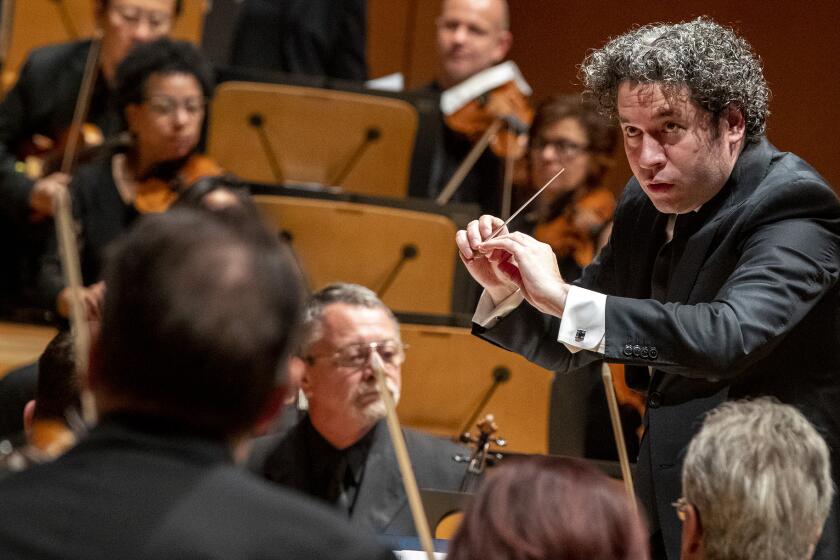Esa-Pekka Salonen has a ‘Ring’ in the making. Orange County gets a sampling

- Share via
For years Esa-Pekka Salonen has been gingerly circumnavigating “The Ring.” He has programmed the occasional orchestral and vocal excerpts of Wagner’s four-opera colossus with the Los Angeles Philharmonic and elsewhere. But only now has he taken the plunge with “The Finnish New Ring” in his hometown, Helsinki.
The cycle began with “Das Rheingold” at Finnish National Opera at the end of September. “Die Walküre” arrives late spring. The final two operas, “Siegfried” and “Götterdämmerung” are slated for the 2020-21 season. It is a very Finnish affair, indeed, with a cast and creative team unlikely to be recognized outside Scandinavia.
“Rheingold” was live-streamed, and the provincially naturalistic production by Anna Kelo reflected the Nordic roots of Wagner’s epic drama. The one international aspect was Salonen’s conducting, giving the whole affair a brilliantly commanding power.
The L.A. Phil conductor laureate has joined the faculty of the Colburn School, and on Sunday afternoon at Renée and Henry Segerstrom Concert Hall, he led the Colburn Orchestra in an electrifying concert performance of the first act of “Walküre.” Before that, Salonen led a characterful reading of “Mathis der Maler,” which Salonen will conduct next week in a guest appearance with the New York Philharmonic.
Typically the New York press announces Salonen as the conductor who got away from the New York Philharmonic, not that the orchestra was ever known to chase after him. But as it turned out, the conductor who did become music director of the New York Philharmonic, Jaap van Zweden, happened to use this very act of “Walküre” to help sell himself to New Yorkers three years ago. And wouldn’t you know it, on Saturday, Van Zweden just happened to be in his native Amsterdam conducting a concert version of, you guessed it, “Die Walküre.”
Since Van Zweden’s performance was broadcast live on Netherlands Radio, listening to it made an interesting prelude. Both were dramatically compelling performances. The main difference was that Van Zweden provided the Wagner we know. Salonen glimpsed the Wagner every generation keeps trying to figure out.
Comparisons are, of course, inherently unfair, but in this case not entirely. Hearing Salonen live was the very big advantage over a broadcast. But what Van Zweden presumably had in his favor was a major professional orchestra, the Netherlands Radio Philharmonic, which he once headed and which performs opera regularly.
Van Zweden’s performance was very good. He gets a rich Wagnerian sound and he drums up big moments for maximum effect, always a plus in Wagnerian circles. He had a strong cast. He did a swell job underscoring the lyricism and grandeur in this truly weird act in which Siegmund, wounded in battle, stumbles into Sieglinde’s hut one stormy night. She’s the wife of the domineering Hunding, Siegmund’s enemy. Siegmund and Sieglinde discover they are long-lost twins, fall hopelessly in love to the loveliest of springtime music and run off together in heroic splendor. Taken at Van Zweden’s powerful face value, you accept the unacceptable.
Prior to L.A. Phil tour, Gustavo Dudamel revisits Andrew Norman’s mind-blowing centennial commission, “Sustain,” in a shrewd pairing with Bruckner’s Fourth Symphony.
In searching for what makes the music tick, though, Salonen winds up questioning what makes Wagner tick. That inevitably means uneasiness.
To do so effectively, and given that this was a concert performance with the orchestra onstage, Salonen made the act more about the orchestra than the singers. Rather than bringing his Finnish cast or implying theater, he accommodated three experienced Wagnerian singers with their own well-fashioned ideas about their roles. After warming up, Simon O’Neill, who was also Siegmund for Van Zweden’s New York Philharmonic dates, rang out spendidly. James Creswell, who replaced Eric Owens, was a convincingly threatening Hunding.
Although she didn’t announce it, Waltraud Meier, one of the great Wagner singers of our day (and the Isolde for the Paris Opera staging of the “Tristan Project” with Salonen,) sang the last Sieglinde of her career. It is a role she has owned for more than a quarter century. Obviously, she can’t be Sieglinde forever, but firm vocal control isn’t everything. She has presence. She has a sense of what a phrase means, and what is behind the sentiments.
She is a modern Sieglinde, an evolved one, taking matters in her own hands to strike out against an abusive relationship. She is the force who guides her less-bright twin. Let him think it’s love. She’s running the show and knows what needs to be done.
You can easily tell Colburn is a student orchestra by the players’ youth. You can’t tell so easily if you close your eyes. Salonen sought out, and got, myriad Wagnerian sound worlds. Those peculiar Wagnerian tubas tell you about strangeness as much as Stravinsky’s music did.
Rhythms had the aggressive punch of a “Rite of Spring.” But Wagner was also the unrivaled master of doubt and insecurity clothed in deceptive bravura. Salonen had full sweep of the act from beginning to end, while simultaneously uncovering the ways in which Wagner, consciously or subconsciously, counteracted that sweep. The act ended, as it is supposed to, in a rush of triumph, yet here all the rush was a foreboding of triumph.
And now for another battle of bands. The L.A. Phil, on tour with Gustavo Dudamel, will perform Bruckner’s Fourth Symphony at Lincoln Center on Nov. 24. Two nights earlier, the Metropolitan Opera’s popular new music director, Yannick Nézet-Séguin, brings his Orchestre Métropolitain of Montreal to Carnegie Hall with the same symphony. Make your bets, please.
For the historic gala concert Zubin Mehta, Esa-Pekka Salonen and Gustavo Dudamel show why versatile musicians are the unsung stars of the L.A. Phil.
More to Read
The biggest entertainment stories
Get our big stories about Hollywood, film, television, music, arts, culture and more right in your inbox as soon as they publish.
You may occasionally receive promotional content from the Los Angeles Times.













